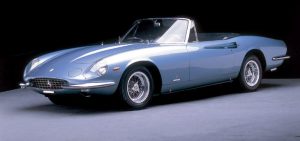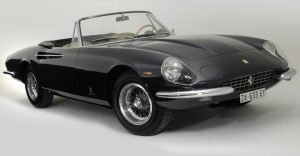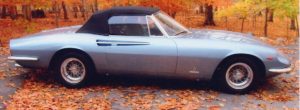
The sixties chapter closed on the exclusive limited production series of Ferrari models with the Pininfarina designed 365 California model, a cabriolet that was presented at the 1966 Geneva Salon. This model was essentially the direct successor to the 500 Superfast coupe, albeit with a folding canvas roof, and was produced during 1966 and early 1967, in a total of only fourteen units, in the chassis number range 08347 – 10369, two of which, 09985 and 10369, were right hand drive.
This makes it an even rarer car than the 500 Superfast, and apart from the 275 GTS/4 NART Spyder, the rarest sixties series production Ferrari road car. Chassis number 08347 was the prototype for the series built on a 330 GT 2+2 type 571 chassis, whereas the production series started with serial # 09127, using a chassis with type reference 598. Like the 500 Superfast, the chassis’ were sent to Pininfarina who bodied and trimmed them at their plant in Grugliasco, and then returned them to Ferrari for the fitment of the mechanical components. Apart from cosmetic ancillary details, like the standard Plexiglass covered headlights, hidden swivelling driving lights in the upper nose panel, a lack of vents on the wing sides, the provision of a central bonnet bulge, and a body side crease line, the 365 California was visually similar to the 500 Superfast model from the windscreen forward. From the A post rearward the real differences occurred, with the doors featuring an arrowhead shaped scallop near the upper edge, which ran into the rear wing, with a central chrome strip incorporating the door handle. The scallop was a design detail that Pininfarina had previously featured on a Dino prototype shown at the 1965 Paris Salon, and would carry through into 206/246 and 308/328 series production models spanning some twenty plus years. The rear wings curved slightly upwards over the rear wheels, with a top ridge line that fell at an angle to the edge of the flat boot lid, which with the wings dropped gently into an unusually angular Kamm tail that appears slightly at odds with the curves at the front of the car.
As with the 500 Superfast the 365 California featured tail light assemblies that were unique to the model, being angular units to suit the shape of the tail corner, with triple circular lenses in a reflective surround. However, there were differences between the reflector colours and even the lens units on individual cars. Again, as on the 500 Superfast, quarter bumpers were provided to each corner, although one example, chassis # 08631, was fitted with a full width rear bumper, and concurrently an amended tail light layout, when refurbished at the factory in 1970. The Borrani wire wheels stayed in place on this model, even though most of the mainstream Ferrari production cars had cast alloy wheels as standard equipment.
The leather upholstered cabin provided a 2+2 seating arrangement, the large doors allowing easy access to the rear compartment. The dash panel was a flat teak veneered panel that ran down in sweeping curves on its lower edge to form the forward part of the centre console, which ran between the front seats, continuing to form an armrest between the rear seats. The speedometer and rev counter were in separate large circular pods projecting from the dash face directly in front of the driver, whilst there were three smaller centrally mounted pods for oil temperature and pressure plus water temperature gauges, below which on the dash face was a radio bounded by the fuel gauge and an ammeter. Electrically operated windows were fitted, actuated by rocker switches either side of the cigarette lighter in the centre console, to the rear of the gear lever and ashtray. There was no external release for the boot lid or fuel filler flap, instead there were a pair of chrome plated levers in the rear cabin side trim panel to facilitate these functions.
The bodies were mounted on a 2650mm wheelbase chassis that had factory reference number 598, and all were numbered in the odd chassis number road car sequence, without any suffix letters. They were constructed along similar lines to the concurrent 330 GT 2+2 model, and featured similar independent front suspension, rigid rear axle with leaf springs and telescopic shock absorbers, four wheel disc brakes, with separate front and rear hydraulic circuits, and the model was fitted with the power assisted steering that was optional on late series 330 GT 2+2 models.
The engine was a single overhead camshaft per bank 4.4 litre V12 unit, with factory type reference 217B, with a total cubic capacity of 4390cc, and a bore and stroke of 81mm x 71mm, with outside the vee sparking plug arrangement, fitted with a bank of three twin choke Weber 40 DFI/4 carburettors, with a twin coil and rear of engine mounted distributors ignition system, to produce a claimed 320bhp. The engine was coupled to a five speed all synchromesh gearbox, with drive taken through a propeller shaft to a rigid rear axle. This engine was based on the original Colombo “short” block design, and was subsequently upgraded and used in the 365 GTC/S and 365 GT 2+2 models.
Engine
- Type front, longitudinal 60° V12
- Bore/stroke 81 x 71 mm
- Unitary displacement 365.86 cc
- Total displacement 4390.35 cc
- Compression ratio 8.8 : 1
- Maximum power 235 kW (320 hp) at 6600 rpm
- Power per litre 73 hp
- Valve actuation single overhead camshaft per bank, two valves per cylinder
- Fuel feed three twin-choke Weber 40 DFI/5 carburettors
- Ignition single spark plug per cylinder, two coils
- Lubrication wet sump
- Clutch single-plate
Performance
- Top speed 245 km/h
Chassis
- Frame tubular steel
- Front suspension independent, unequal-length wishbones, coil springs, telescopic shock absorbers, anti-roll bar
- Rear suspension live axle, radius arms, semi-elliptic springs, coil springs over telescopic shock absorbers
- Brakes discs
- Transmission 5-speed + reverse
- Steering servo-assisted recirculating ball
- Fuel tank capacity 100 litres
- Front tyres 205 x 15
- Rear tyres 205 x 15
Bodywork
- Type two-seater spider
- Length 4900 mm
- Width 1780 mm
- Height 1330 mm
- Wheelbase 2650 mm
- Front track 1405 mm
- Rear track 1397 mm
- Weight 1320 kg (dry)






You must be logged in to post a comment.